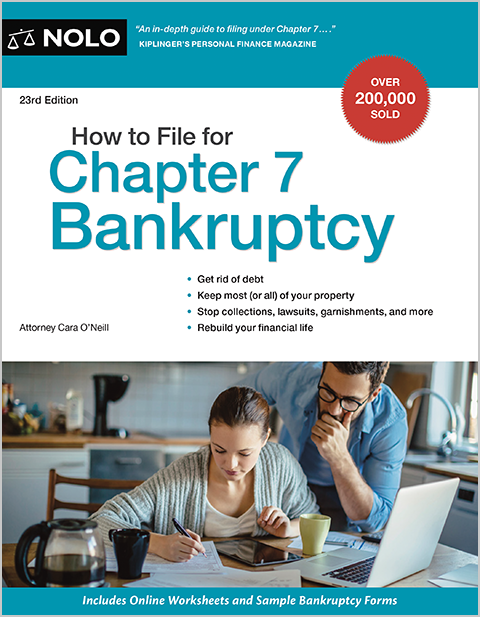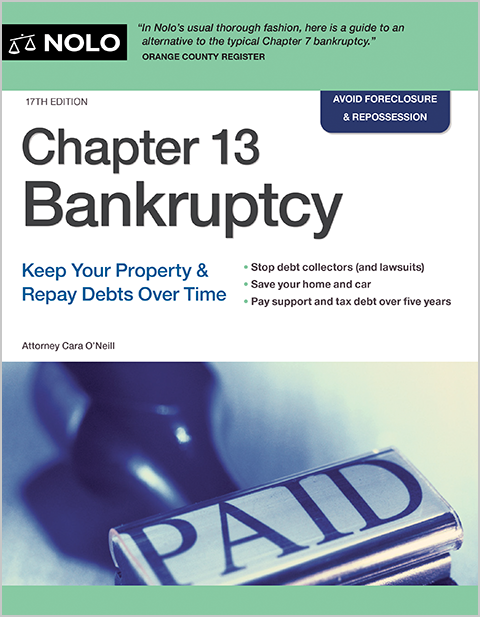Sometimes you can keep two cars when you file for Chapter 7 bankruptcy. In this article, we explain the requirements for keeping two cars in Chapter 7, including the following:
- You'll need to be able to protect all of your vehicle equity using a bankruptcy exemption.
- If you're making car payments, you must be current on the loan.
- You might have to show that making the payment won't cause undue hardship.
We also explain how to keep cars in bankruptcy when you can't protect all of the vehicle equity with a bankruptcy exemption, including how to protect your car by filing for Chapter 13.
- Can I Protect the Equity in Two Cars?
- How Do I Determine If I Can Keep Two Cars in Chapter 7 Bankruptcy?
- What Happens If I Have a Car Loan in Chapter 7 Bankruptcy?
- How Redemption Works in Chapter 7
- How Reaffirmation Works in Chapter 7
- Paying the Lender Informally
- Can I Keep Two Cars in Chapter 13 Bankruptcy?
- Need More Bankruptcy Help?
Can I Protect the Equity in Two Cars?
When you file for Chapter 7 bankruptcy, you agree to give up specific property in exchange for a discharge of debt. A discharge order eliminates your obligation to pay for qualifying debt, such as credit card balances, medical bills, and personal loans. But you won't give up everything you own.
Whether you can protect the equity in two cars will depend on the property your state allows you to "exempt" or protect. If your state's exemptions cover the equity of both vehicles, you can keep both cars.
Below we explain more about the exemption process and other vehicle protection methods in bankruptcy.
How Do I Determine If I Can Keep Two Cars in Chapter 7 Bankruptcy?
Determining whether you can keep property in bankruptcy is a multi-step process. First, you must figure out whether you have a right to keep your vehicle equity. Here's how it works.
Find out how much property you can protect. Each state decides which property its residents need to maintain employment and a home. You'll find the property you can protect in the exemption laws. There are two sets: state and federal exemptions. Some states allow filers to choose between state exemptions and federal exemptions. Still, in most states, you'll use the state exemptions.
Calculate your vehicle equity. Research the value of the cars. Subtract any car loans or liens you'd need to pay if you sold it. The amount remaining is the equity.
Find out how much vehicle equity you can exempt. Most states let you exempt some motor vehicle equity using a motor vehicle exemption (some states allow you to spread the exemption amount over multiple cars). You can protect more equity if your state has a wildcard exemption that you can use for any property you choose. In most instances, you can stack the wildcard exemption onto the motor vehicle exemption.
However, suppose you can't exempt the total value of both vehicles. In that case, you might have to turn one or both cars over to the bankruptcy trustee appointed to your case. The trustee will sell one or both cars, pay you the exemption amount, and use what remains after deducting the trustee's fee and sales costs to repay unsecured creditors according to the bankruptcy priority payment rules.
Decide if you want to buy back any nonexempt equity. If you pay the nonexempt portion (the amount you can't protect) to the trustee, you can keep the car. You'll have to use the income earned after the bankruptcy filing date or borrow money from a friend or relative. However, the trustee might give you a discount due to the saved sales costs. Learn more about the motor vehicle exemption.
Example. Ava owns two cars that she paid off long ago. One is worth $2,000, and the other $4,000. Her state allows her to exempt $4,000 in vehicle equity, leaving her with $2,000 of nonexempt equity. She must pay the trustee $2,000 (minus any discount allowed) to keep both cars.
What Happens If I Have a Car Loan in Chapter 7 Bankruptcy?
Determining whether you can protect the equity in your cars is just the first step if you still owe money on either vehicle. The next step involves making arrangements to continue to pay the car loan. Here are some ways to do this:
- redeem the vehicle (pay its value in a lump sum payment)
- sign a reaffirmation agreement (a new contract), or
- continue paying the loan without the protection of a contract.
How Redemption Works in Chapter 7
If the fair market value of your car is worth less than what you owe, you can ask the court to allow you to pay the actual value in one lump sum payment. Redeeming the vehicle, as it's called, is rarely used for obvious reasons: Most debtors don't have the ability to come up with the funds. Your bankruptcy attorney might be able to direct you to a redemption lender but be prepared to pay a high-interest rate.
Example. When Justin financed his car, he received a high-interest loan due to his bad credit. When he later filed for Chapter 7 bankruptcy, his vehicle was underwater—he owed $10,000 on a car worth only $5,500. His mom agreed to give him the $5,500 needed to redeem the car in Chapter 7 bankruptcy. Justin's bankruptcy attorney filed the necessary paperwork and received approval from the judge.
How Reaffirmation Works in Chapter 7
A more common approach is signing a reaffirmation agreement (a new contract) with your lender in which you agree to continue making your regular monthly payments. Usually, your payments must be current when you file for bankruptcy because your lender doesn't have to agree to include overdue payments in the reaffirmation agreement. The lender might agree—but you can't count on it.
Also, you'll have to show the court the following:
- reaffirming the debt is necessary
- the payment amount is reasonable, and
- making the payment won't cause you or your family undue hardship).
So, you'll need to demonstrate that you need two cars and that the payments are affordable and reasonable under the circumstances. Expect the court to examine your income and expense schedules to determine whether there's sufficient room in your budget for the car payments.
Example. When David decided to file for Chapter 7, he was married to Olivia, but he filed alone to preserve Olivia's good credit. David had two car loans in his name—one for his car and one for Olivia's vehicle. The car payment on David's car was $400, and the car payment on Olivia's car was $550. Both spouses worked and needed separate transportation. The court approved reaffirmation agreements because the payments were reasonable and necessary and wouldn't cause undue hardship.
Paying the Lender Informally
Some lenders will allow you to keep a car without a reaffirmation agreement if you remain current on the payment. The benefit is that if the vehicle gets damaged or repossessed, you won't be responsible for paying anything. However, without the protection of a contract, the lender could take the car back without warning. Some courts prefer that filers use this approach instead of taking on new debt immediately after bankruptcy.
For more on your options for dealing with car debt in Chapter 7 bankruptcy, see Chapter 7 Bankruptcy and Your Car.
Can I Keep Two Cars in Chapter 13 Bankruptcy?
Yes, because you don't lose property in Chapter 13. However, keeping property in Chapter 13 can be expensive. Why? Because you must pay for any nonexempt equity through the Chapter 13 bankruptcy plan.
As with Chapter 7, you'll start by determining how much equity you can protect in your vehicles using bankruptcy exemptions. If you have nonexempt equity, you'll pay at least that amount toward unsecured debt, such as credit card balances and medical bills, in your repayment plan—possibly more. The amount paid for a mortgage, car loan, or another secured debt won't count toward this requirement.
This rule ensures the following:
- filers can keep property they'd otherwise lose in Chapter 7, and
- creditors receive as much in Chapter 13 as in Chapter 7.
While Chapter 13 can help you keep property you'd otherwise lose, people with a lot of nonexempt property equity often don't make enough income to pay the required monthly payment. For instance, suppose you wanted to keep two high-end cars with $60,000 in combined nonexempt equity. In that case, you'd pay a minimum of $1,000 monthly over 60 months, plus trustee fees, in addition to other required amounts.
Need More Bankruptcy Help?
Did you know Nolo has made the law easy for over fifty years? It's true—and we want to ensure you find what you need. Below you'll find more articles explaining how bankruptcy works. And don't forget that our bankruptcy homepage is the best place to start if you have other questions!
|
Our Editor's Picks for You |
|
|
More Like This |
Can I Keep My Car in Chapter 7 Bankruptcy? Your Property in Chapter 7 Bankruptcy The Motor Vehicle Exemption: Can You Keep Your Car in Chapter 7 Bankruptcy? |
|
Other Articles You Might Enjoy |
How to File for Bankruptcy in Your State |
|
Helpful Bankruptcy Sites |
We wholeheartedly encourage research and learning, but online articles can't address all bankruptcy issues or the facts of your case. The best way to protect your assets in bankruptcy is by hiring a local bankruptcy lawyer.
|
|
- Can I Protect the Equity in Two Cars?
- How Do I Determine If I Can Keep Two Cars in Chapter 7 Bankruptcy?
- What Happens If I Have a Car Loan in Chapter 7 Bankruptcy?
- How Redemption Works in Chapter 7
- How Reaffirmation Works in Chapter 7
- Paying the Lender Informally
- Can I Keep Two Cars in Chapter 13 Bankruptcy?
- Need More Bankruptcy Help?

